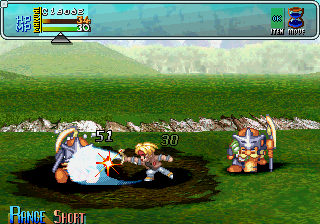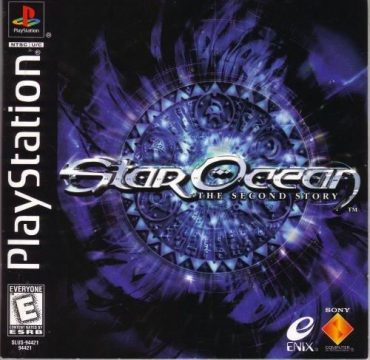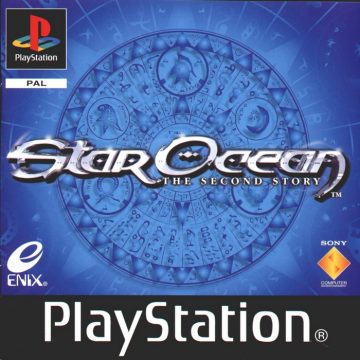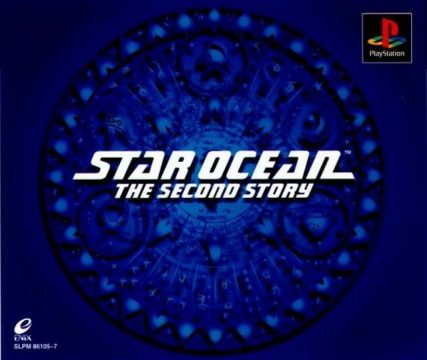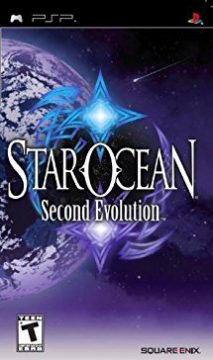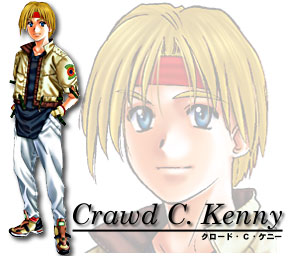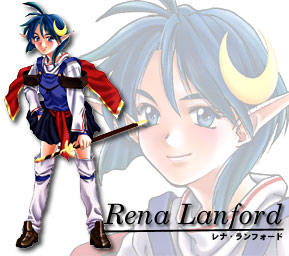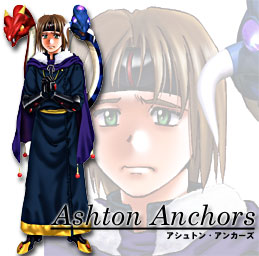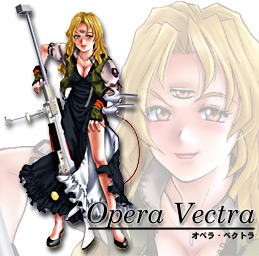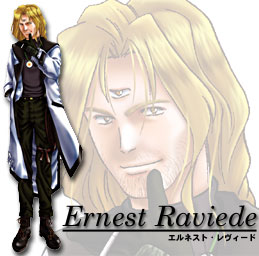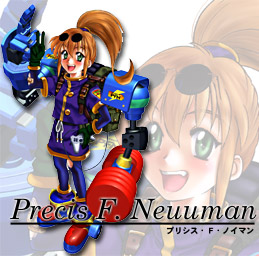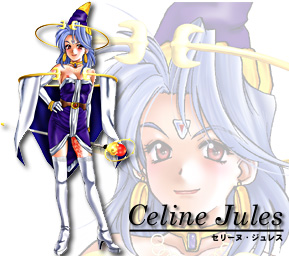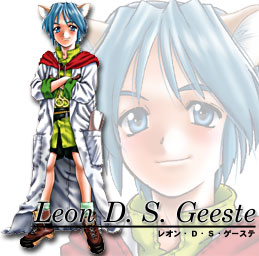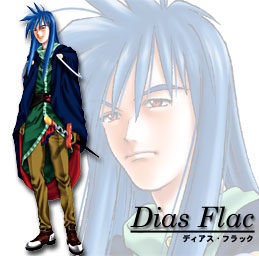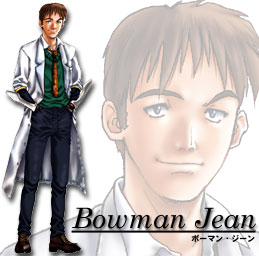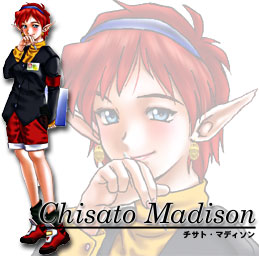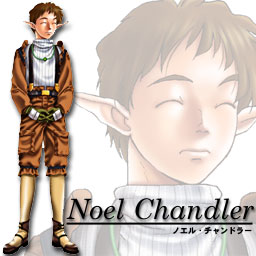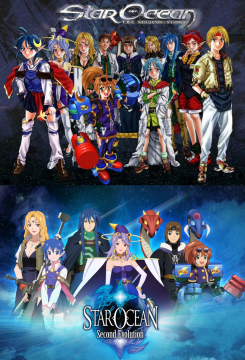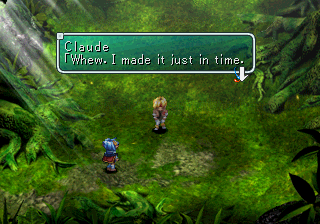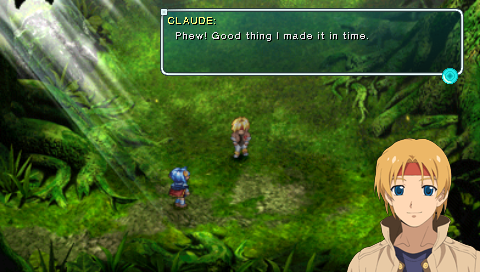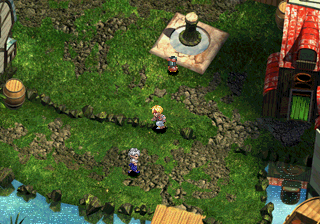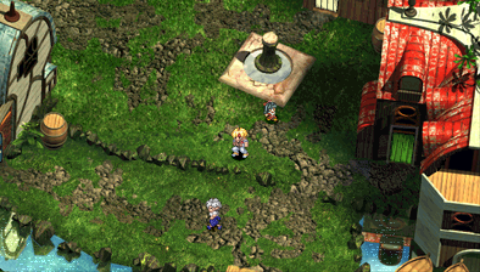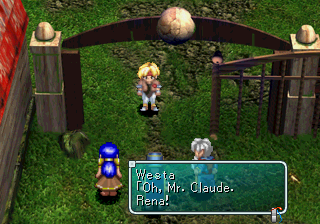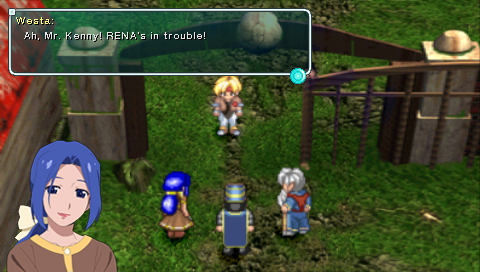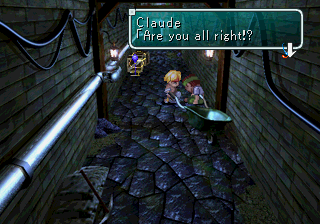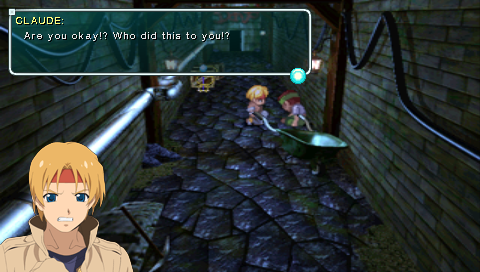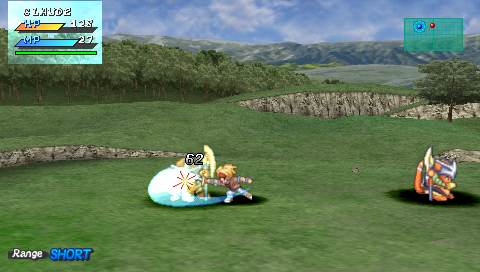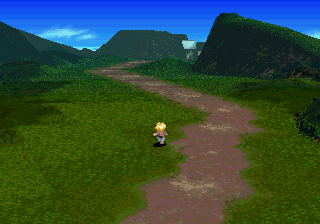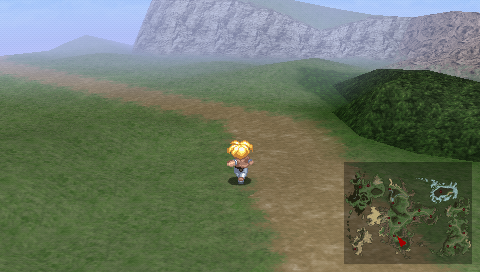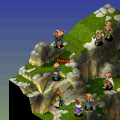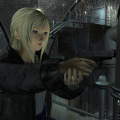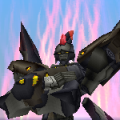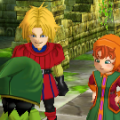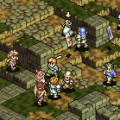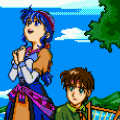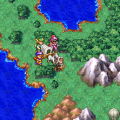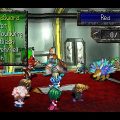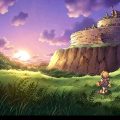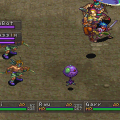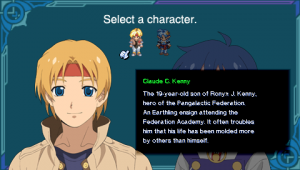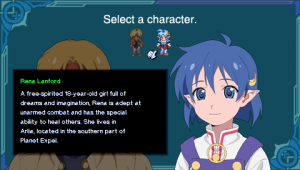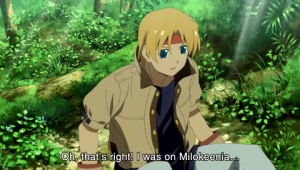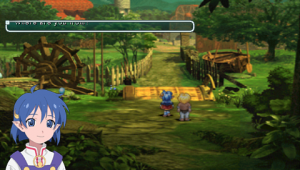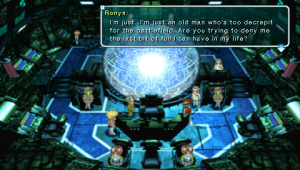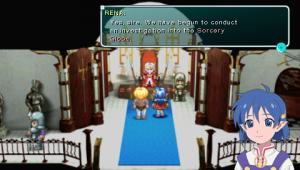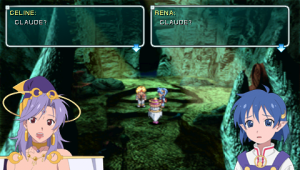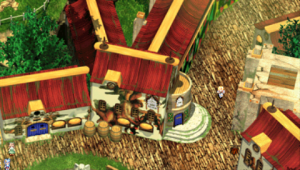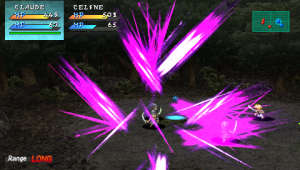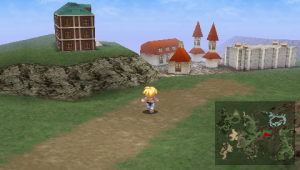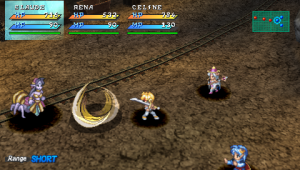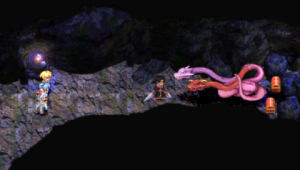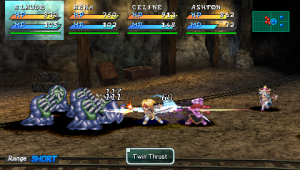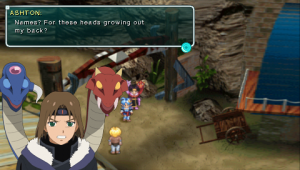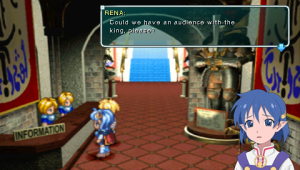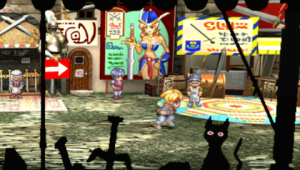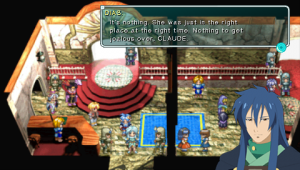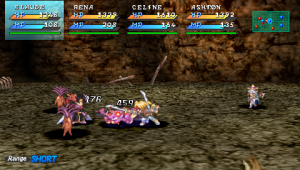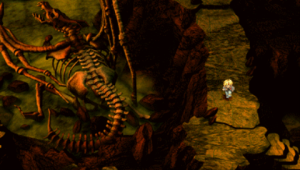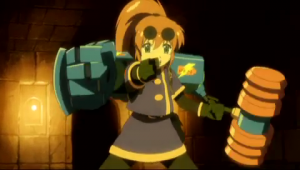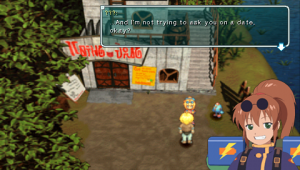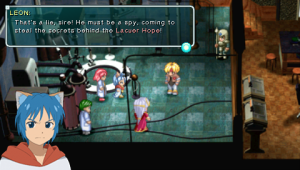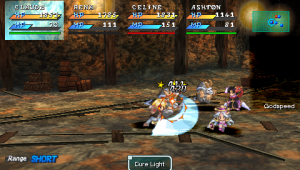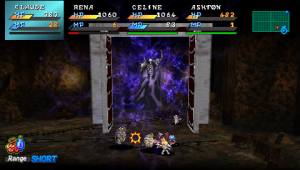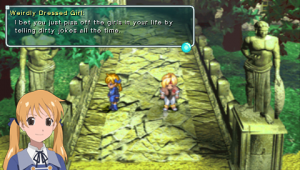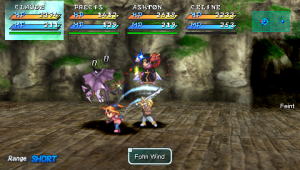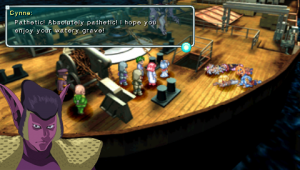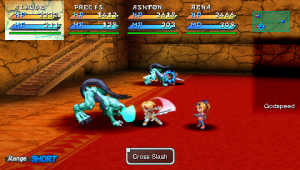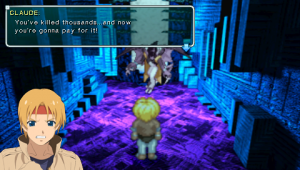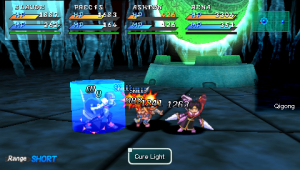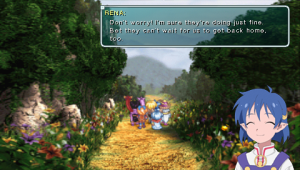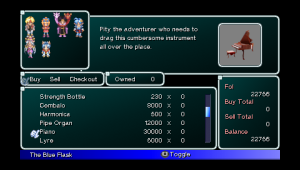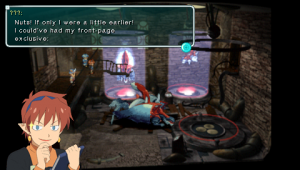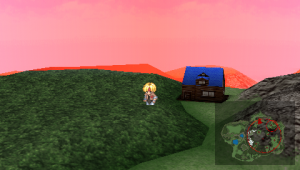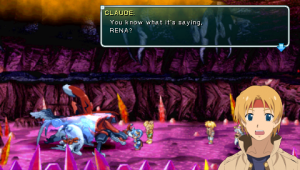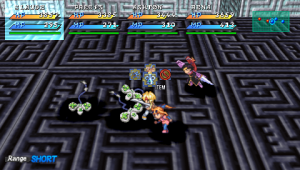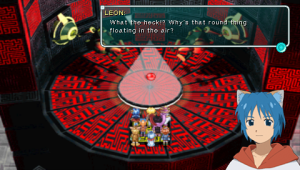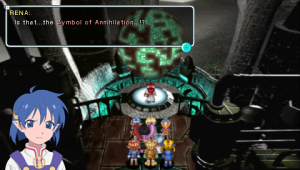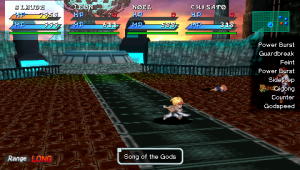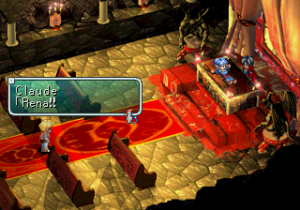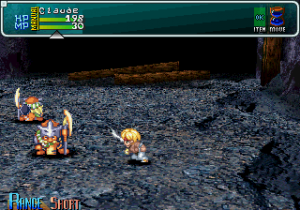- Star Ocean
- Star Ocean: The Second Story
The original Star Ocean was released in the twilight days of the Super Famicom’s life, with the PlayStation having already been on the market for nearly two years. Not very long after, Square shook the industry by releasing Final Fantasy VII, the game that not only solidified the PlayStation as the RPG system of choice, but also introduced the genre to the overseas mass market. In just two years, Tri-Ace got together and created a sequel to Star Ocean, that, while not quite having the budget of Square’s cinematic epic, took influence from it while still maintaining its own identity.
The story takes place twenty years after the first game, focusing on Earth space captain Ronyx (Ronixis in the PS1 version) Kenny and his young adult son Claude. While on an away mission, Claude is accidentally sucked through a mysterious portal and ends up transported to a medieval planet called Expel. Almost immediately after regaining consciousness, he finds a young girl named Rena about to be attacked by a ferocious monster. When leaping to her defense, he uses his laser pistol, thereby violating the Star Trekian “Underdeveloped Planet Preservation Pact”, the one that was specifically created so lesser civilizations wouldn’t look at space travelers as gods.
Predictably, Rena looks at Claude’s strange clothes and “magic” laser gun and comes to the conclusion that he’s the foretold Hero of Light that would save the world from destruction. Indeed, things on Expel have worsened over the years, largely thanks to a mysterious meteor called the Sorcery Globe, that has recently crash landed and brought with it a plague of monsters. Despite his reluctance, and with no communication back to his father or his starship, Claude teams up with Rena to explore the land and research the origin of the Globe.
Characters
Claude C. Kenny
The son of Ronyx Kenny from the original Star Ocean, Claude serves as an ensign on his dad’s ship, the Cainus, before accidentally becomes stranded on Expel. He originally just wants to get back home, but becomes embroiled in the plans to save the planet. Referred to as “Crawd” in Japanese artwork.
Rena Lanford
The other main character, Rena is a Nede, basically Star Ocean’s version of an elf. She lives with her mother in the village of Arlia on Expel, where she discovers Claude after he’s transported there, and acts as his guide after he saves her from a kidnapping. She’s the group healer.
Ashton Anchors
A symbologist swordsman with a bit of bad luck. When the heroes first meet him, he’s cursed by a dragon, who appears as two heads attached to his back. (Their names are Gyoro/Creepy and Ururun/Weepy.) Since Claude and Rena are technically responsible for his misfortune, they offer to help find a cure, and so Ashton joins their adventure. If you recruit him, then neither Opera nor Ernest can join your party.
Opera Vectra
Opera is a Tetrageniot, a race that has a third eye on their foreheads. When the party first meets her, she’s looking for her boyfriend, Ernest. She attacks using assorted high tech weaponry, most of which are functional at long range.
Ernest Raviede
Ernest is Opera’s boyfriend, an interplanetary explorer who’s found himself possessed by a ghost. After being exorcised, he joins the party along with Opera. His primary weapons are whips.
Precis F. Neumann
A cheery teenage girl who lives in the town of Linga, she follows in the footsteps of her scientist father and spends her time tinkering with mechanics. She travels with her robot Robbie (Bobot) and fights with a mecha named Puncher attached to her back. If she joins, you can’t recruit Bowman.
Celine Jules
A treasure hunter and princess of the Krosse royal family. Celine is a symbologist, basically wielding offensive magic.
Leon D.S. Gehste
A genius child symbologist living in the kingdom of Laceur. He’s a cat-like Fellpool, the same race as the main characters from the original Star Ocean. He’ll also only join permanently in Claude’s scenario.
Dias Flac
A brooding hero archetype, Dias is Rena’s childhood friend, who has since left the village by the time the game begins, having blamed himself for a tragic incident in his past. He looks at Rena as a little sister, though Claude views him as a romantic rival. A strong swordsman, he only joins the party permanently in Rena’s route.
Bowman Jeane
A pharmacist in Linga, who joins to help investigate the sorcery globe, he attacks with pellets with various effects but is also a strong physical fighter.
Chisato Madison
A newsporter reporter who’s also a Nedian, just like Rena, who fights primarily with tasers. She’s one of the last characters since she shows up in the second half of the game, and since your party can only hold eight, there’s a good chance that the player will have to choose between her and Noel.
Noel Chandler
A cheerful Nedian zoologist at a wildlfie refuge, he’s a combination of a fighter and healer.
The biggest elements taken from Final Fantasy VII are the pre-rendered backgrounds and the 3D world map, moving away from the continuous field of the SFC Star Ocean. However, it sticks with using sprites rather than polygonal models, and applies a blur filter them as they move towards and away from the camera, so it doesn’t look at pixelly as something like Xenogears. It’s obvious Tri-Ace didn’t have remotely the same budget as Square, so the backgrounds aren’t nearly as distinct nor as detailed. But the trade-off is that areas, especially dungeons, tend to be larger and more complex than the comparatively linear paths of Final Fantasy. There are a small number of CG cutscenes, that concentrate mostly on landscapes getting destroyed, but they looked rather cheap back when it was released and come off even worse nowadays.
The battle system has also been updated so that the action takes place on a 3D battlefield, which is much larger than the single screen arenas of the original SFC game. It’s a little bit awkward in the way it works – you can technically now move around, but by default you have to hold down the Square button. However, fundamentally it works the same as before, as you target an enemy then run up and hit them. The main character can also be controlled by an AI too, if you want to sit back and watch. There are some additions that try to make it a little more action-based, like jumping enemies that will dodge regular attacks, or falling rocks that need to be dodged. There’s also a (rarely used) feature that lets you cast two spells from characters, allowing for a combined super attack.
On the whole, it’s a more interesting and exciting expansion on the real-time system set down by the first game, but some of these still cause issues. Many enemies have attacks that are much quicker than any of your party members, allowing them to stun you mid-attack. It’s very easy to get cornered or caught between two enemies, and get butchered before you get a chance to react. The fact that the battlefield is so large makes it difficult to see everything that’s going on, which is especially a problem when trying to interrupt magic-casters. While there are a few more AI commands, they’re still rather vague, especially when you want one of your party members to attack a specific enemy. These issues don’t really affect most of the fights, but every once awhile you’ll get wiped out due this sort of jankiness.
It’s especially a problem in the end game, where the final dungeon (and resulting final battles) have such a huge difficulty spike that it’s almost impossible to beat unless you specifically know the special tricks in order to beat it. (Hint: develop pickpocketing skills and find the NPC with the Bunny Shoes.) And that’s just on the default setting – there’s an optional subquest that lets you take off the “limiter” of the final boss, making it even more ridiculously difficult. Thankfully the steps to do this are so obtuse that it’s unlikely a first-time player will do this on their own.
The major upside is the fact that you get Rena, a healer, right at the start of the game. Since she’s set to autoheal, generally she’ll save any of your AI party members before they get killed, so at least you don’t have to worry about them screwing up too badly. It also reduces the need to constantly have to stop and heal in the early parts of the game, as you did in the first game.
The skill system is fundamentally the same as before, with some minor tweaks. New are the Super Specialties, which are group abilities that are obtained when your party members cumulatively have high enough ranks in certain skills. For example, Master Chef lets you combine two ingredients to make a more powerful dish, while Publishing (or Publication) lets you pick specific characters to write books, rather than being applicable to skills. These can tweak various friendship or romance points, and can also be sold to publishing houses for royalties. Come On Bunny (or Bunny Call) lets you summon a gigantic bunny to quickly travel the overworld, like Star Ocean‘s equivalent to a Chocobo. Reverse Side (or Contraband) lets you make super powerful “illegal” items, which can, for example, let you stay at any inn for free, or get insurance so you get some cash if one of your characters is KOed in battle. If you fail though, you get a “bounced check” item that will continuously drain your cash until it sell it (which also costs money).
These additional skills in Star Ocean 2 make it possible to totally break the balance of the game. This is a lot of fun in its own way, and indeed, basically required if you want to have a chance at the high difficulty levels. Still, anyone looking for strategic depth to their fighting systems will not find it here (or any Star Ocean for that matter).
Beyond the myriad of skills, there’s also a relatively large amount of optional content. Right at the beginning of the game, you can choose between playing as Claude or Rena. Fundamentally this doesn’t change a whole lot – the introduction is different, obviously, and there are a handful of spots where the two diverge and you can see their unique viewpoints. Ultimately it doesn’t affect the story too much, and you can switch leader characters at your will regardless. However, each route has a unique playable character – Rena drafts her older-brother figure swordsman Dias, while Claude gets Leon, a genius young boy scientist. Both of these characters appear on the story regardless.
It’s a good idea, but clumsily implemented due to both how the story is written and the abilities of the characters. Claude is obviously the standard hero-fighter character, but since Rena is a healer, she’s not very good at fighting, so you might as well put someone else in charge of the party anyway. Plus, at the beginning of the game, when Rena gets kidnapped, all you do is sit around and wait for Claude to rescue you. Though this has only a minor affect on the overall game, it would’ve been nice for her to be more pro-active.
Other than that, technically all of the other playable characters (total of twelve in the PS1 version, thirteen in the PSP/PS4/Vita versions) are optional. Some of them will join during the course of the story and they you decide to have them stick around permanently or boot them from the team. However, others require taking on various subquests to find.
As with the first game, certain characters are mutually exclusive. At an early town, you find some NPCs making reference to a man fighting dragons in a cave, who turns out to be Ashton. If you hunt him down and have him join, that means you can’t ever meet Opera or her boyfriend Ernest. You’ll probably never even see them during the course of the game. Similarly, there’s one town where you can either draft Precis, the young girl scientist, or Bowman, the pharmacist. But the game never tells you that can’t get one if you don’t get the other. Similarly, it’s easy to miss one of the optional subquests to find these characters because they tend to happen only during Private Actions, which are easy to miss. As with before, you really need to play with a FAQ in hand if you want to understand everything.
Again, it’s just as well, because Star Ocean 2 isn’t terribly lengthy. It’s quite a bit longer than the first game – by the time the story really gets into gear is about the same point, time-wise, that the first game was wrapping up. A standard playthrough, even when going for the larger subquests, will probably only take about 20-30 hours, making it a fair bit shorter than the Final Fantasy games of the era. That’s one of the game’s greatest strengths too – even though it wears the clothes of a 32-bit RPG, its storytelling and pacing are closer to a 16-bit one. The introduction, as Rena introduces Claude to the world, is drawn out, and the first half of the game is a little slow, as the plot barely progresses as the team is introduced to all of the party members. But the second half of the game is much more interesting, as the heroes fight on a second planet called Energy Nede, and have more direct confrontation with the villains.
The characters are generally pretty fun, managing to be diverse and unique without being obnoxious (with a few exceptions). Some parts are juvenile – the constant teasing about the romantic tension between Claude and Rena, as well as Rena’s idolation of Dias and Claude’s jealousy, grows tiresome – but they’re never intolerable. Similarly, even though the story involves whole planets being destroyed, it’s never as melodramatic as Final Fantasy VII or VIII, nor is the story as bloated or confusing.
Ultimately the story isn’t anything fantastic, even if it is longer and more involved than the first game. The villains are revealed to be mysterious beings called the Ten Wise Men, who, fitting neatly into a 90s JRPG cliche, are named after various Christian angels. It’s something that alluded to in one of the dungeons, which weirdly has Christian iconography and paintings on the walls. However, the English PS1 version changes all of their names to hide this connection – the main bad guy, Gabriel, was changed in Indalecio.
Motoi Sakuraba’s soundtrack is similar in style to the SFC game, though the instrument set is closer to the other 32-bit games he worked on, like Sony’s Beyond the Beyond and Camelot’s Shining the Holy Ark. And it sounds absolutely fantastic. The towns themes (and Rena’s theme) are accompanied with beautiful flutes, the battle themes are intense prog rock pieces accompanied pounding drums and trumpets, and the dungeon themes alternate between adrenaline pumping Falcom-esque synth rock and atmospheric creepiness. It’s one of Sakuraba’s most consistent works, with barely a bad song among the seventy or so tracks. Even the more discordant tracks, like the boss themes, shine through with their sheer, raw energy.
In the PS1 version, speech is limited to a brief clip in the introduction, as well as battle speech and cries. In the English release, these are spectacularly bad. The actors are obviously amateur, and not only is much of it grating but some clips are practically indecipherable due to the low sound quality. (The more egregious example is Ashton’s “Tear into pieces!” which sounds closer to “Pear into peaches!”) Characters like Precis become almost unusable due to how obnoxious she sounds. Someone on the voice recording team mistranslated “bunny” as “Barney”, so every time you summon a rabbit familiar they yell “Come on Barney!” Still, it adds a ridiculous, cheesy charm, if you can tolerate it.
Ten years after its initial release, in 2008, Square-Enix ported Star Ocean 2 to the PSP to accompany the remake of the first game, now given the subtitle Second Evolution. The chain of evolution is a little confusing – the SO1 PSP remake took many aspects from SO2 while making a few upgrades, all of which were carried forward to SO2 on the PSP. However, it’s not really a “remake”, but rather an enhanced port.
The biggest addition is the full voice acting for nearly every scene (discounting minor NPC interactions). As with the remake of the first game, it’s a professional job, with Spike Spencer taking on the role of Claude and Claudia Lenz (AKA Eden Riegel) as Rena. The secondary characters are great too, especially Precis, whose loopy valley girl lilt makes her silly lines work. However, there’s no way to turn off the voices, and while you can skip through it, it makes skipping through dialogue slower. The battle voices are much, much better, though there is something missing about the goofiniess of the PS1 original. Some things that were nonsensical before are changed too – Claude’s victory speech of “Well, that’s somewhere around 80 points!” was changed to something like “I’d say that’s about a 8 out of 10” to make it clearer that he’s ranking their battle performance.
The translation has also been completely redone. The PS1 version, done by SCEA, isn’t as bad as some of their other slipshod efforts (Final Fantasy Tactics, Legend of Dragoon), but it was still fairly middling, with much characterization removed and plenty of awkward dialogue. The new translation is much better, although, along with the voice acting, highlights the fact that the source material often wasn’t very good to begin with. Along with this, many items and other names have been altered.
All of the major characters also have portraits to accompany their dialogue. These aren’t bad, but compared to the original PS1 designs, they’re a little too clean and generic looking, seeming like they came out one of the Tales games. Rena also looks a little too young, considering she’s supposed to be 18. It’s also pretty weird that they didn’t bother to give Ronyx a portrait – he’s not a major part of the plot, but he was one of the stars of the first game, so he deserves that much! There are also a few new anime FMV cutscenes using the new art, most of which is decent, but the new anime-style vocal theme isn’t a patch on Sakuraba’s instrumental work.
Some of the prerendered backgrounds, the ones that scroll horizontally, were made to fit naturally into the PSP’s widescreen view. Others had to be stretched out in order to fit the whole screen. The overall quality is mixed, but generally you can’t tell anything looks too out of whack unless you directly compare them to their originals. The sprites are identical but look a little blurrier, to mask the pixellation. The battle backgrounds have been changed a bit, and make the transition to widescreen smoother since they weren’t prerendered to begin with. They look cleaner, though some of the obstacles, like the falling boulders, have been removed. The world map has also been completely redesigned with cleaner textures, though it has a lower draw distance and more fog. The voice quality is improved, but the music sounds a little worse, since it’s missing the reverb of its PS1 counterpart.
The battle system carries forward some of the changes made to the PSP port of the first Star Ocean, primarily in giving every melee character a three-hit combo by default instead of just one attack repeated over and over. This alone makes the game slightly easier, but there are other balance tweaks too, particularly in making spell casters more powerful and reducing the time it takes to cast magic. To balance this out, the spell combinations, where you could cast two specific spells at the same time for a super powerful attack, have been removed. These were extremely difficult to pull off to begin with, so it’s no big loss. Other quality of life improvements are nice too, like the speeding up of spell and item crafting animations, and various glitches have been fixed to.
Again, as with the SO1 PSP port, Welch from SO3 has been added as a playable character, and with her are new Private Actions and endings. She feels even more out of place and redundant here though, especially since she’s not all that different from Precis.
Overall, any upgrade that makes substantial changes to a well-loved product is going to be met with some resistance by fans, especially the translation and battle system tweaks, as well as the new voices and artwork. Still, in general, it’s an improvement over the PS1 release, and should be regarded as the definitive version.
In 2015, to accompany the release of Star Ocean 5, the PSP version was ported to the PS3, PS4 and Vita, which was only released in Japan. Other than a new intro song and the addition of trophies, it’s identical.
Taken altogether, Star Ocean 2 is in equal measures beautiful and messy. The story is functional and rarely offensive, and while aspects of the skill system and the optional content are frustrating, they’re welcoming to people to either like to futz with (and break) gameplay systems or those who enjoy replayability.
But more importantly, the game represents a branch of JRPGs that was never fully explored. Star Ocean 2, with its non-combat skills and optional stuff, takes after Western RPGs, where non-linear and experimentation are rewarded. The effect of Final Fantasy‘s cinematic aspirations meant that many other games in the genre followed in its footsteps. This included Star Ocean, which scaled back all of these aspects and replaced them with far more ambitious, but generally worse, storytelling. It’s these reasons why Star Ocean 2 is regarded as the best of the series.
The PS1 release of Star Ocean: The Second Story was successful in North America, but was especially popular in Japan, where it led to a manga and anime series called Star Ocean EX.
Screenshot Comparisons
